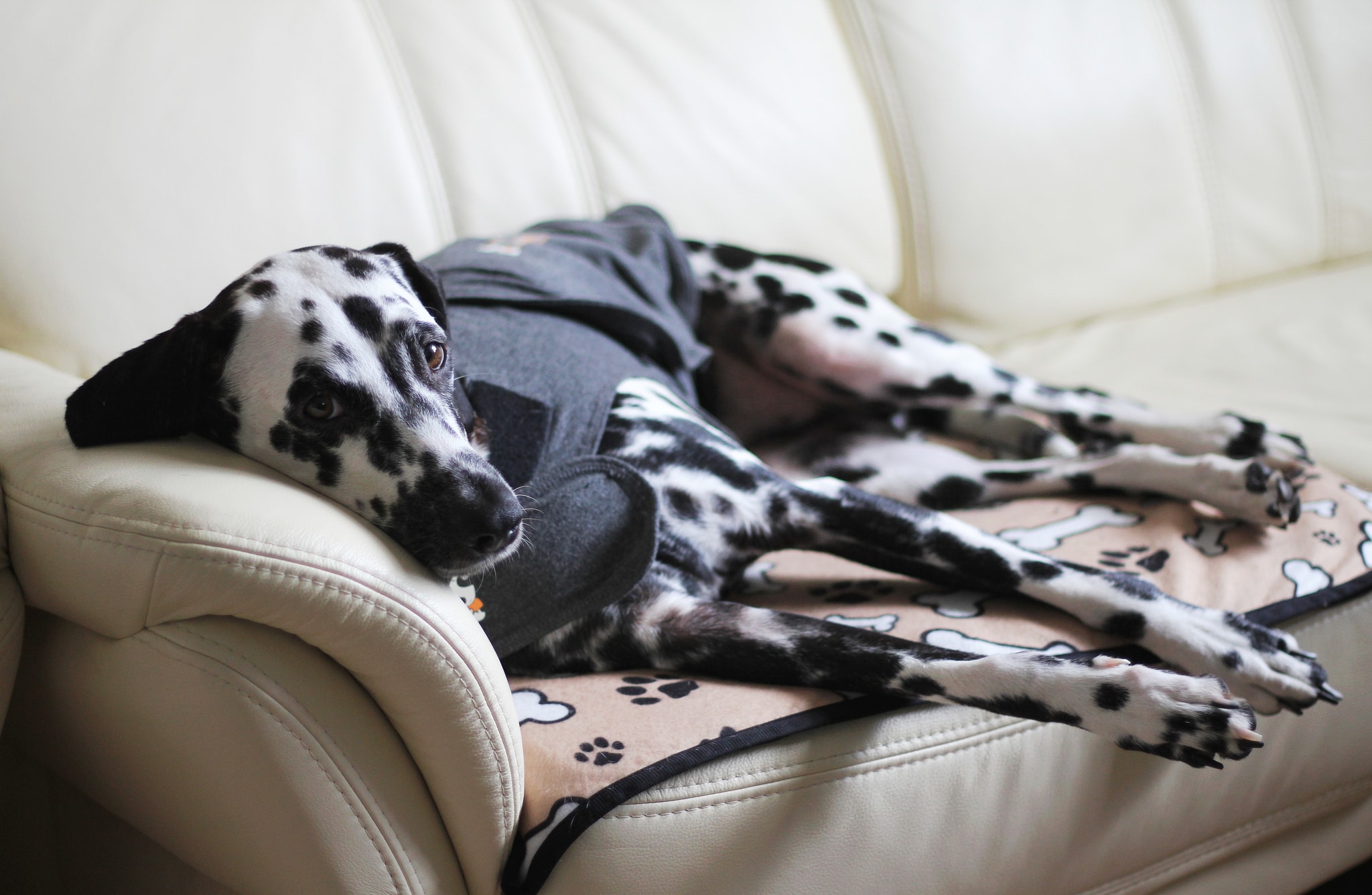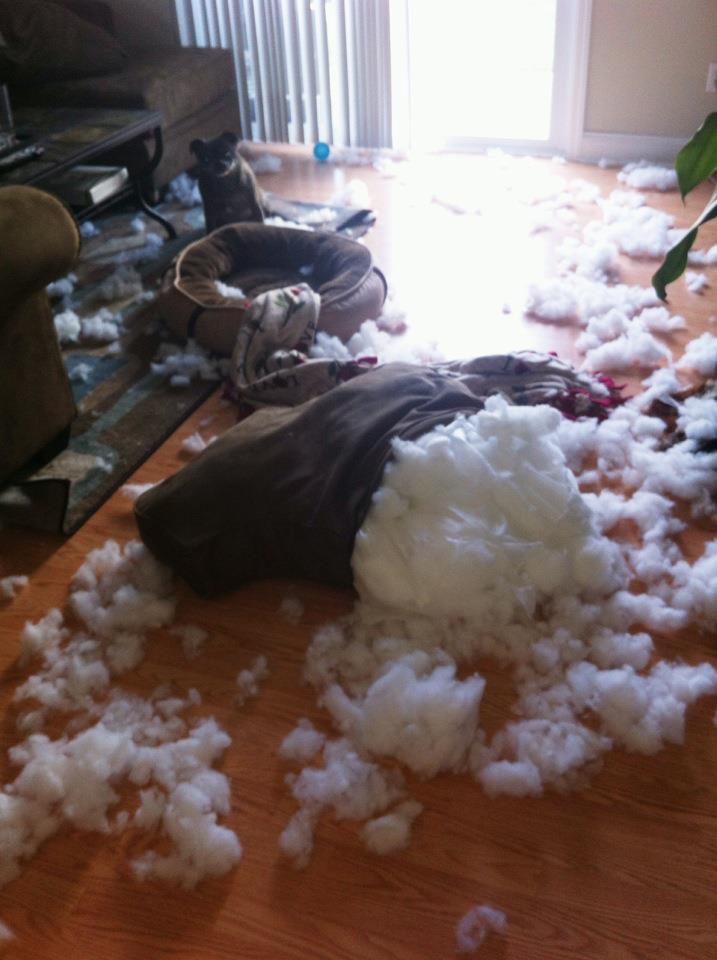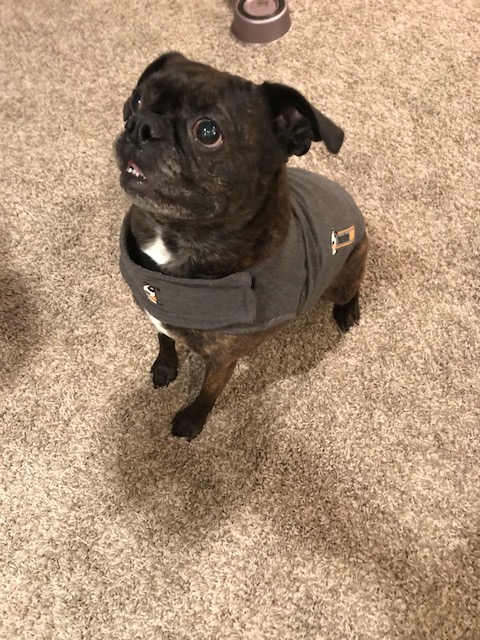How to quickly cure your dog of separation anxiety

Does your dog suffer from separation anxiety?
Anxiety is not only a human experience but one your dog experiences too.
However, our dogs have different triggers and causes for anxiety.
I’m a pet sitter and have been for years, I have seen my fair share of anxious dogs.
That’s why I’ve tried everything when it comes to helping a dog cope with their anxiety.
I’ve also cured my own pup, Mylie, from her separation anxiety. When I would leave her alone she would take all of the pillows off the couch and pull out the stuffing! On occasion, she would escape her play area and destroy anything she could - pillows, plants, slippers and even ate my checkbook!
This is just one example. I was worried I would never be able to leave her out during the day while I was at work so I did some research on her behavior. I’ve learned a lot over the years dealing with this problem first hand.
In this guide, I’ll give you all details on how I helped Mylie and everything you need to know to cure your pup of anxiety quickly! Including a full review of the Thundershirt and why it’s the best drug-free solution.
What causes anxiety
There are many causes of anxiety in animals. According to the American Kennel Club and Merck Veterinary Manual, the top causes of dog anxiety are:
- Separation
- Fear
- Aging
Separation anxiety
Through my research, I learned that Mylie had separation anxiety. Separation anxiety happens when your pup is not comfortable being left alone.
Destroying furniture, urinating and barking are some of the behaviors you will see when your pup is stressed. The damage is usually done by doors or windows, where they try to escape or wait for you (not patiently!).
Your canine may even try to break out of their dog crate or play area - as Mylie did!
Next time you leave your house, pay attention to how your pup is acting. They know when you’re about to leave, and you can notice their behavior start to change.
Fear-based anxiety
Fear based anxiety in your dog is caused by loud noises like fireworks or unfamiliar people with a uniform or hat on. Even environments such as car rides, going to a park or vet visits can trigger your pooch.
Age-based anxiety
Age-based anxiety can happen when a dog’s normal routine is changed. It is also observed in dogs as they get older and their sight and senses decline. When they can’t see or smell as well as they used to and they become anxious.
How to tell if your canine has anxiety
If you’re not sure if your pup has anxiety, here is a simple test you can conduct when you leave for the day. I did this test with Mylie a few times to see how she would react. This will tell you if your pup has separation anxiety.
- Set up a camera to see how they react while you’re gone during the day. You can use a dog camera (read our top choices here), use a webcam or a friend’s phone.
- After you close the door and leave, check your camera to see how your dog is behaving.
- Wait 5 minutes and see if they’re circling, barking, or yawning.
By following these simple steps you’ll know how anxious they are when you leave.
If they have fear-based anxiety, then you’ll notice a change in behavior as you introduce them to new environments, like when they go to the park or the vet.
Anxiety from aging develops over time and also becomes more pronounced when your dog encounters unfamiliar territory.
What behavior should you look for?
Each dog handles this problem differently. Some dogs will try to avoid the situation or escape while others will exhibit more aggressive behavior. The root cause of this is the fight or flight response to the situation.
I mentioned a few symptoms of anxiety above, but here is a full list of behaviors you should lookout for:
- Panting
- Depression
- Destructive behavior like ruining furniture
- Restlessness
- Urinating indoors
- Excessive barking
- Becoming obsessed
Different levels of anxiety
There are different levels of anxiety. When I would return home for the day and see that the house was a disaster, Mylie would try to avoid the area where she did the destructive behavior and run upstairs. Here are some immediate reactions you can look for in mild and panic anxiety levels:
- Mild: some signs include tail tucked between their legs, withdrawal or hiding and escape behaviors
- Panic: some signs include active escape behavior, and increased activity for no reason, signs of nervous system activity such as diarrhea

This picture is from when my dog Mylie was a puppy. She suffered from separation anxiety and would take it out on my pillows when I was away!
Is there a way to prevent anxiety?
There is no easy way to predict if your new dog or puppy will develop anxiety, but there are some ways to try to avoid anxiety-related issues.
You want to take notice of:
- Your pups nutrition and exercise
- Your pups body language and how they react to different situations
- How much training your pup is getting and how well they listen to you
- How they handle socialization with other dogs and humans
Daily walks and food
Taking your pup for daily walks is important for their development, physical and mental well-being. You will notice that a more stimulated dog is less likely to showcase destructive behaviors and you should note that their nutrition is equally important to their health.
Know when your canine is uncomfortable
Read your pup’s body language. Knowing when your dog is uncomfortable or scared can help you avoid negative experiences and even use them as a positive training moment. Body language can also tell you when your dog is getting anxious.
Socialization is so important (even with adult dogs!)
Socializing your canine with different environments, humans and other animals can help prevent anxiety. As mentioned, anxiety can come from not knowing what is going to happen next and unfamiliar experiences. Introduce your pup to as many different surfaces, humans and social situations as possible, and they will become a happy, stress-free pup.
Doggy daycare and home boarding services can also be an option and one of the steps of your socialization plan.
Training is the main ingredient
Training is as essential as socialization. It’s the perfect tool for preventing and even managing anxiety.
Along with socialization, it lays the foundation for building a relationship with your pup. A trained dog can socialize more easily, and classes are a perfect place to start your pup. They can meet other dogs in a controlled environment with skilled trainers.
Avoidance - Should you or shouldn’t you?
If you notice your dog growls or pulls on the leash around dog parks, you may want to avoid them or slowly introduce them by walking them around the fence first. This goes back to paying attention to their body language.
For example, some dogs don’t love the idea of being crated and some of their anxiety may come from being in an enclosed area. Find a more open area in your home to leave them.
By opening up the area, they are less likely to feel trapped and may feel less stressed. This was the case with Mylie. She didn’t like being in a cage or in an enclosed area. She does better in open areas.
Are you stressed out?
Dogs are sensitive and can read your anxiety level. This may increase their anxiety. Try different relaxation techniques to lower your stress - like yoga or meditation.
What to do when you observe an alarming behavior
If your pup goes into mild or panic anxiety, stay calm and take note on what is causing this reaction. This will help you understand and avoid the stimuli that is causing the panic until you have a plan in place. Once you know the triggers, you can prepare for the situations ahead of time.
This is exactly what I did with Mylie. I watched her behaviors and recognized what was triggering her reactions - separation.
If you do not know what the trigger is or would like a second opinion, talk to your vet or enroll your pup in training. Here’s why.
Talk to your vet
You can talk with your vet if you are unsure what type of anxiety your dog suffers from and they can help identify the possible triggers. Your vet can also check to make sure there are no medical conditions causing the symptoms.
Training
The purpose of training is to change their response to the stimuli responsible for anxiety, usually by replacing the anxious or aggressive behavior with a more desirable behavior, such as focusing on you. There are different solutions that can help supplement the training as well. Don’t give up!
Why it’s important to help your dog through the anxiety
It’s important to help them get over their anxiety so that it does not lead to persistent behavior issues. You want your pooch to feel relaxed and to enjoy life. Having your house destroyed while you’re at work will stress you out too!
Reviewing the ThunderShirt: is it the best solution?
After learning about separation anxiety, I realized I was enabling Mylie’s behavior. I should have started a plan to prevent her behavior. I did my research and found out about the ThunderShirt. I can tell you by personal experience that the ThunderShirt is the best solution I’ve found for relieving her anxiety.
How does it work?
The ThunderShirt works by applying a gentle but constant pressure on your dogs pressure points. Using pressure to relieve anxiety is a common practice and was exactly what Mylie needed.
This works in a non-invasive way - similar to swaddling an infant using pressure to reduce anxiety, except with the ThunderShirt your pup can move freely and even use on walks.
The ThunderShirt is a drug-free anxiety solution for:
- Loud noises; such as thunder or fireworks
- Leash pulling
- Separation anxiety
- Excessive Barking
- Travel; including car rides and vet visits
- Crate anxiety
- Grooming
Willa is a fun and loving German Shepard mix, read her story below!
Comfort
The fabric is breathable and light so you do not have to worry about your pup overheating. As you would with any sweater or shirt, I would watch your furball for the first couple of days to make sure they’re comfortable and that it’s not on too tight. Dogs typically cool themselves through their mouths and paws so they should be fine!
Another reason I chose to give ThunderShirt a try is because of how reasonably priced they are. There are different versions available such as Classic, Polo and Sport. Check out the current prices on Amazon.
Sizing
The size you choose really matters because you want the Thundershirt to be snug on your dog. There are seven sizes available. The options range from XXS for dogs weighing less than 7 pounds (Chihuahua or Yorkshire Terrier) to XXL for dogs up to 110 pounds (Great Dane or Mastiff).
It’s a good idea to measure your dog before you order to make sure you get the right fit. Here’s how to measure:
The standard Classic version comes in gray with the orange logo, which features a dog hugging itself. There are also blue and pink colors available for dogs. The box includes a reusable drawstring storage bag and detailed instructions. Finally, the shirt is machine washable and holds up after you have washed it a number of times.
You can read more reviews and purchase the Thundershirt on Amazon.
Why you should use ThunderShirt
This product is an inexpensive drug-free option that allows you to work with your pooch on a daily basis. They were also ranked the most effective solution for anxiety by veterinarians in a 2011 survey!
Not to mention, if you don’t see a change in your pups behavior they offer a money-back guarantee. I saw a gradual change in Mylie’s behavior over a few weeks of easing her into being home alone.
Most importantly, it’s a solution that could really help!
I know what you’re thinking, will this work for my dog?
Check out Willa and Mylie’s story below!
Meet Willa, a German Shepard mix that was rescued by one of my best friends. When they brought home Willa, she seemed to have anxiety after being alone in the shelter. Willa has now completed training and wears her ThunderShirt to help with her anxiety.
You can notice it is snug on her and she even takes walks with it on! Not to mention my friend puts in time with her including play dates, walks and has her interact with different friends and family members on a regular basis. She is a great example of how hard work can pay off.

Meet Mylie, my Boston Terrier/Pug mix aka Bugg. Yes, she is the one that destroyed the couch in the first picture. We have had Mylie since she was a pup. She grew up with me working from home and always being around her. When she got a little older, it was hard for her to be home alone.
We used the ThunderShirt for when we would leave, and after awhile she became okay to being home alone for a few hours at a time without destroying the house. Now, at age 6, she is left home alone and not in a crate. She has the whole house to explore! I give this a ten out of ten paws. I love it because it’s a drug-free solution!
How to use the ThunderShirt
The “shirt” is easy to use. Follow these easy steps and watch the video below for a demonstration. Your box will also come with a detailed diagram and instructions.
- Place the Thundershirt on your dog’s back.
- Wrap the flap under the torso.
- Secure the shirt with the Velcro straps. Done!
Check out this quick video for more instructions:
Other solutions for your dogs’s anxiety
You may be wondering what else could you do for you pup. You can always consult with your vet on the best treatment for you dog, but there are other solutions you can try. These range from different puzzle toys to long-lasting chews that can keep your puppy occupied.
If you’re looking for more guidance don’t be afraid to try a training program. Depending where you live there are programs you can enroll your them in locally.
A company called ThunderWorks also offers other solutions such as ThunderEase and ThunderEssence. ThunderEase replicates pheromones for a drug-free calming solution that puts an end to bad behavior. ThunderEssence contains natural essential oils from Lavender and Chamomile. The oils provide a wide variety of calming and health benefits for your pup.
Note: I have not tried either one yet, but when my next anxious pup arrives I will have to give them a try! We just want to make you aware of other possible solutions.
What should you do next? Create a strategy and treatment plan
With Mylie, I did my research, tried the ThunderShirt and slowly introduced her to being alone. I had an exercise and training plan in place and stuck to it!
If you’re struggling with a solution and thinking about medication - don’t give up yet!
Medications have side effects and can become expensive. With the ThunderShirt, you’ll know in a short amount of time if it’s working for your dog or not. It’s also a one time purchase.
Try training with the shirt on your dog to see if you can get more immediate results.
Creating a step-by-step plan (like I did with Mylie) may be one of the most important things you can do to help. I know firsthand that when your dog has anxiety it can also take over your life. You are always cleaning up after them or letting it get in the way of enjoying life.
Come up with a plan and remember to always reward good behavior! Introduce the interactions slowly and limit the amount of time of exposure. Add more time as they become more comfortable.
Be patient, work with your pup and reward them on their progress!
-Candice Crichfield
Candice Crichfield has had the joy of taking care of many pets in her life including her two current family members, a French bulldog and a Boston Terrier-Pug mix aka a Bugg. She owns a home boarding service and over the past decade taking care of animals has become her passion.
Feature image: Maja Dumat
